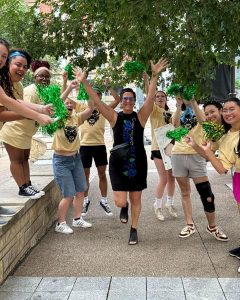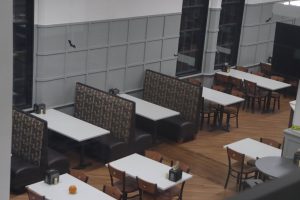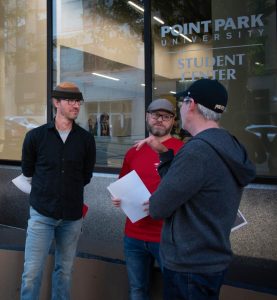Students adjusting to remote learning
September 15, 2020
Point Park University is heading into its second week of the 2020-2021 school year. The beginning of any semester is full of change, while both students and faculty adjust to their new course schedules and responsibilities. This year is full of much more adjustments than usual, as students at Point Park and beyond learn in and outside of the classroom with new learning models to help promote social distancing and de-densification efforts on campus.
Kayley Brookes, a junior civil engineering technology major at Point Park, said that this transition has been a difficult one.
“The transition has been difficult, as it requires much more self discipline and time management,” Brookes said. “Five out of six of the courses I am taking are asynchronous, in which the professor posts videos for us to watch in replacement for attending class . . . I really enjoy this format, as it is very flexible and allows me to be able to get a job and work flexible hours. However, it is very easy to get behind as you are in charge of your own learning and time management.”
“I won’t lie, it’s pretty hard to focus,” said Grace Offerdahl, a senior Sports, Arts, and Entertainment Management (SAEM) major at Point Park. “The technological barrier exists, and it can be hard to get around it. My professors are definitely trying their best, but there’s only so much you can do online.”
She continued, saying that there are setbacks to remote courses that may cause students to struggle.
“It’s so much easier to focus when in person,” Offerdahl said. “Distractions are gone, and you can connect with people face to face. It’s easier to hear, to take notes, and to interact with other students.”
Jonas Prida, Assistant Provost at Point Park, said that he facilitated any planning leading up to this semester.
“One of the recommendations of the COVID-19 taskforce was to increase students’ opportunity to take courses remotely,” Prida said. “From there, I facilitated a team of deans, chairs, coordinators, faculty members, and the registrar’s office. From early in the summer until the start of classes, we had twice-weekly meetings about how to de-densify the campus and remote courses were part of the plan.”
Before the semester began, students were able to fill out a form on PointWeb to indicate which of the courses they were going to take remotely, as opposed to in-person.
Brookes said that this option was useful for her and that the process was simple.
“My experience requesting remote courses was very seamless,” she said. “I didn’t have any issues, and all my professors have been very adaptive to the new technology. I actually had two courses scheduled for the same day . . . Now that courses are remote I was able to work out an arrangement with my advisor and professors that allowed me to take both courses since they meet virtually.”
Offerdahl agreed that the process was simple, but it had its setbacks.
“The only thing I didn’t like was I still didn’t know if my requests were approved the week before classes started,” she said.
The team, led by Prida, decided that it would be best to allow students to take some of their courses face-to-face this semester.
According to Prida, certain classes can only meet their learning objectives in-person.
“Some courses’ learning outcomes could not be met if the class were offered remotely. We started there,” Prida said. “After that, deans and chairs worked with the Provost’s Office on determining how these courses could be incorporated in a reasonable, and safer manner into schedules.”
Brookes said that, although there are benefits to the remote learning option, it is a much different experience, depending on the type of course the student is taking.
“Something my remote courses give me that in-person classes don’t is flexibility. Civil Engineering is notorious for having Saturday classes which has caused me to miss out on many important events . . . This semester, however, I was able to visit my family for a weekend by taking my class online from my home,” Brookes said. “On the other hand, my lab classes are virtual as well, and it is difficult to get the same experience. Lab classes are designed to be hands-on and stimulating, which they are not when you’re watching a YouTube video of other students completing the lab.”
Brookes chose to take her courses remotely for safety reasons, but also because she felt she would thrive better in a remote environment.
“I made the decision to take all of my classes remotely as I didn’t feel comfortable interacting with six different groups of people per week,” she said. “I also just didn’t feel like I would thrive in a socially distanced classroom where you cannot eat or drink. I felt like I would be more comfortable at home where I can do work in a more suitable environment with no restrictions or fear.”
Offerdahl is taking her courses remotely from her hometown for similar reasons.
“I wanted to make the safest decision possible for myself and my family,” she said. “Once the virus started, I moved from Pittsburgh back to my hometown in Ohio, and I’ve been living here since then. … Once they announced classes could be remote, I decided to take them all online so I could stay home and save some money.”
Prida stated another factor that played into the decision to come back to campus was that there was a lot more time to plan, unlike last spring, when classes were abruptly switched to a remote format.
“Since we had more than four days to figure out how to teach these courses in a safer environment (unlike the Spring), and we had a creative group of faculty working on the project, I was fairly confident that the students who wanted to be on campus could be, and ones who wanted to learn remotely also could be accommodated,” he said.
Brookes said that she found the information provided by the university before the beginning of the school year had helped explain the changes that were taking place.
“I think Point Park adequately expressed the expectations of students for living on campus and explained in depth the class model options that students would experience,” she said.
Offerdahl appreciated the option of being able to take courses remotely. Unlike Brookes, however, Offerdahl thought that the communication could have been better.
“We got a lot of emails from the school, but they all said the same thing and none of it felt like super important information,” she said. “A week before classes started, I still didn’t know if all my courses were approved to be fully online.”
Another point of contention for Offerdahl was that students who are taking their classes fully remotely are still paying the same price as in-person students.
“I really wish Point Park would have offered some tuition assistance to those who are fully remote,” she said. “I am not receiving the same education, so why am I paying the same price? I know it was a choice, but I shouldn’t be punished for choosing what made me feel safe.”
Prida said that the faculty and staff that participated in the planning handled obstacles with grace.
“…One thing we did well was bringing together people from a wide variety of disciplines and faculty positions to help think through this extremely challenging problem,” Prida said. “Every time one problem was solved, two more sprung up and that can be frustrating to deal with. My colleagues have an amazing amount of patience and desire to serve students well.”
Although planning for this semester was difficult, it proved to Prida that the students of Point Park are ready for anything.
“…It confirmed how incredible Point Park students are,” he said. “We asked them to completely change how to experience education, and the overwhelming majority of students have been right on board.”
Brookes said that higher education institutions may take lessons that they learned this semester and apply them to future school years.
“I think that many colleges may continue to offer virtual options for students in the long run, which would definitely be a game changer for many types of students who may have chronic illnesses, those who do not wish to live on campus, those who are working adults or those who travel often,” she said.
Offerdahl agrees that some of these policies may become permanent features.
“I think remote courses will continue to be an option for a couple years into the future,” she said. “Hopefully the cleaning policies stay in place, and I hope that wearing a mask when you’re sick becomes a new norm.”
Prida said that this school year will change how higher education operates, as universities will need to consider now more than ever the appropriate balance of remote and in-person learning experiences.
“Both have important places in a student’s development and we know that students want both,” he said. “The tricky bit will be finding the balance.”





